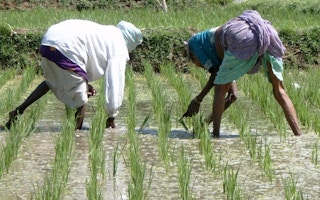As the world warms, monsoon changes are set to cause havoc across a huge and densely populated swathe of the planet. The great South Asian summer monsoon will become both stronger and less reliable.
German scientists predict a pattern of extremely wet years in the future, but the arrival of these will be chaotic. Even a late monsoon can be devastating for those whose lives and livelihoods depend on the rainy season. A failure can be catastrophic.
And yet too much rain can also have calamitous consequences: it can flood ripening grain fields, wash away topsoils and even − by reducing the storage of carbon in the soil − help accelerate further warming of the planet.
Around one billion people depend on the monsoon for their well-being, for trade and manufacture, and for food systems and agriculture. And the years ahead could become more chaotic, as a consequence of global heating driven by profligate use of fossil fuels and the destruction of natural ecosystems worldwide.
“For every degree Celsius of warming, monsoon rainfalls will likely increase by about 5%,” said Anja Katzenberger of the Potsdam Institute for Climate Impact Research.
“We were also able to confirm previous studies, but find that global warming is increasing monsoon rainfall in India even more than previously thought. It is dominating monsoon dynamics in the 21st century.”
She and colleagues report in the journal Earth System Dynamics that they analysed 32 advanced climate simulations to look for a pattern of change in the region’s weather.
About four-fifths of all the region’s rainfall happens in the summer: crop yields − especially rice − are highly sensitive to the monsoon’s coming. Agriculture makes up at least one-fifth of the Indian gross domestic product or GDP, so rainfall is vital to the economic and social well-being of hundreds of millions of people.
During the second half of the 20th century, the trend seemed to be towards a gradual drying of the rains. In the first decades of this century, the pattern seems reversed: monsoons are getting stronger. Quite how tiny annual rises in global average temperatures affect the winds that bring the summer rains has still to be ascertained, but ocean warming driven by human changes to greenhouse gas levels in the atmosphere is almost certainly involved.
Rice at risk
And this is not good news for the farmers who, for generations, have placed their bets on the regular arrival of the rains. There is even evidence that in the deep past, a succession of monsoon failures may have toppled an early civilisation.
“Crops need water especially in the initial growing period, but too much rainfall during other growing states can harm plants − including rice, on which the majority of India’s population is depending for sustenance,” said Julia Pongratz from the Ludwig-Maximilian University in Munich, another of the authors.
“This makes the Indian economy and food system highly sensitive to volatile monsoon patterns.”
And Anders Levermann, also from the Potsdam Institute, said: “We see more and more that climate change is about unpredictable weather extremes and their serious consequences, because what is really on the line is the socio-economic well-being of the Indian subcontinent.
“A more chaotic monsoon season poses a threat to the agriculture and economy in the region and should be a wake-up call for policymakers to drastically cut greenhouse gas emissions worldwide.”
This story was published with permission from Climate News Network.








